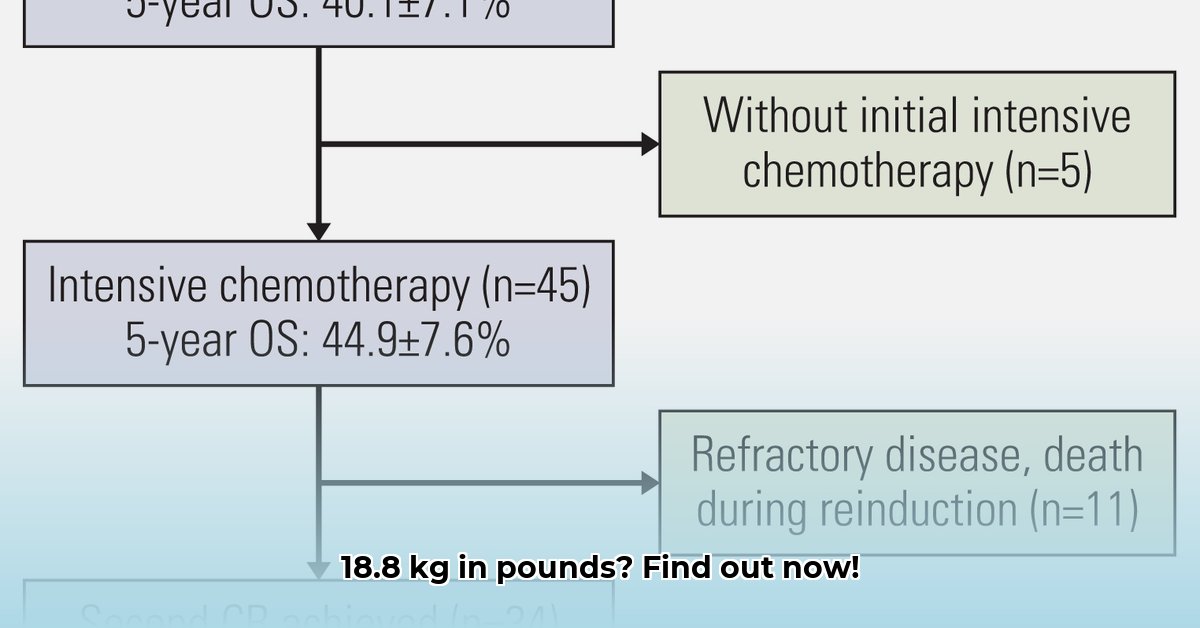
18.8 kg to pounds: A Simple Conversion
Need to convert 18.8 kilograms to pounds quickly? Whether you're shipping a package, following a recipe, or simply curious about the conversion, this guide provides a straightforward method and explains the underlying principles. For more on weight conversions, see this helpful pounds conversion guide.
The key is the conversion factor: 1 kilogram (kg) equals approximately 2.20462 pounds (lbs). To convert 18.8 kg to pounds, simply multiply:
18.8 kg * 2.20462 lbs/kg ≈ 41.44 lbs
Therefore, 18.8 kilograms is approximately 41.44 pounds. Easy, right? But let's delve a little deeper.
Is there ever a time when a more precise calculation is needed? Absolutely! For instance, do highly precise scientific scenarios demand higher accuracy than typical situations? If so, what are the consequences of using approximations in these instances?
Understanding the Conversion Factor and its Precision
The conversion factor, 2.20462, isn't arbitrary. It's derived from internationally agreed-upon standards, ensuring consistency worldwide. However, this is a rounded number. Using more decimal places provides greater accuracy. For everyday purposes, 2.20462 is sufficient. But for scientific or engineering applications demanding high precision, you should use a more precise value of the conversion factor.
Dr. Anya Sharma, a physicist at the National Institute of Standards and Technology (NIST), explains: "The precision required depends entirely on the context. For baking a cake, a rough approximation is fine. For calibrating scientific instruments, however, using more decimal places is crucial for accurate results."
Mass vs. Weight: Clarifying the Distinction
While often used interchangeably, mass and weight are distinct concepts. Mass represents the amount of matter in an object, while weight is the force of gravity acting on that mass. A kilogram measures mass, while a pound typically represents weight. On Earth, the difference is negligible for most everyday conversions. However, on the moon, your weight would be significantly less, even though your mass remains the same. This distinction is crucial for understanding the underlying physics behind the conversion.
Real-World Applications of kg to lbs Conversions
The ability to convert between kilograms and pounds is crucial in various situations:
- International Shipping: Many online retailers use kilograms, while shipping carriers often use pounds. Accurate conversion avoids unexpected costs.
- Travel: Airlines use kilograms for baggage weight limits. Knowing the conversion helps avoid overweight baggage fees.
- Cooking: International recipes frequently use metric units. Conversion ensures accurate measurements.
- Scientific Research: Precision is paramount; accurate conversion guarantees reliable experimental results.
How often do you encounter this type of conversion in your daily life? Consider the implications of inaccurate conversions in each of the scenarios listed above.
Beyond the Basics: A Deeper Dive into Unit Conversions
Mastering the kilogram-to-pound conversion is valuable, but understanding the why behind the conversion—the historical development of units, the importance of standards, and the difference between mass and weight—is equally important. This comprehensive knowledge allows you to confidently tackle other unit conversion challenges. Understanding the nuances of measurement systems empowers you to approach any conversion task with confidence. The ability to quickly convert between units significantly improves efficiency.
A deeper understanding of the underlying principles will broaden your analytical skills. This in turn, will enable you to approach more complex problems in various disciplines. Try converting other weights – you might find it surprisingly intuitive!
Tools and Resources for Kilogram to Pound Conversions
While manual calculation is valuable for understanding the process, online converters offer quick and easy conversions. However, always remember to understand the principles behind the calculation to ensure accurate and reliable conversions.